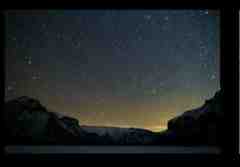 Patch Greenbelt, MD --
Patch Greenbelt, MD --Want to start off the new year by gazing at the stars?
The Quadrantid meteor shower
 is named for an extinct constellation, but the shooting stars that seem to sprout from it still arrive yearly, and the opening of the 2013 show will begin overnight Jan. 1 into Jan. 2.
is named for an extinct constellation, but the shooting stars that seem to sprout from it still arrive yearly, and the opening of the 2013 show will begin overnight Jan. 1 into Jan. 2.The Quadrantids is one of the lesser-known meteor showers of the year, but that doesn't mean it's anything less than spectacular. Take a look at this Quadrantids meteor shower video
 or these pictures of the Quadrantids
or these pictures of the Quadrantids .
.While the shower begins overnight on the first day of the new year, NASA tells us
 Quadrantid meteor shower peaks in the wee morning hours of Jan. 4: "[T]he Quadrantids have a maximum rate of about 100 per hour, varying between 60-200. The waxing gibbous moon will set around 3 a.m. local time, leaving about two hours of excellent meteor observing before dawn."
Quadrantid meteor shower peaks in the wee morning hours of Jan. 4: "[T]he Quadrantids have a maximum rate of about 100 per hour, varying between 60-200. The waxing gibbous moon will set around 3 a.m. local time, leaving about two hours of excellent meteor observing before dawn."*Where to look:*
The best way to spot the meteor shower is to look north (and a little east) and find the Big Dipper (Ursa Major) then look farther north (which would be roughly "up" if the Big Dipper were holding liquid). The constellation Draco ("Dragon") has a "head" of four bright stars that look a little bit like the four stars that make up the cup end of the Big Dipper. "Up" between the end of the Big Dipper's handle and Draco's head, you should spot the meteors. It's near the constellation Boötes.
"Meteor Mark," who writes Meteor Blog, recommends looking near Boötes, and he has another tip
 about spotting the meteors: "Quadrantids can be seen anywhere in the sky and if you see one in an area, you’re likely to see more in that spot, so keep your eyes transfixed to that location.
about spotting the meteors: "Quadrantids can be seen anywhere in the sky and if you see one in an area, you’re likely to see more in that spot, so keep your eyes transfixed to that location.*From NASA:*
The National Aeronautics and Space Administration website gives this description
 of the history of the Quadrantids in astronomy:*
of the history of the Quadrantids in astronomy:**
"Like the Geminids, the Quadrantids originate from an asteroid, called 2003 EH1. Dynamical studies suggest that this body could very well be a piece of a comet which broke apart several centuries ago, and that the meteors you will see before dawn on Jan. 3 are the small debris from this fragmentation. After hundreds of years orbiting the sun, they will enter our atmosphere at 90,000 mph, burning up 50 miles above Earth's surface—a fiery end to a long journey!
"The Quadrantids derive their name from the constellation of Quadrans Muralis (mural quadrant), which was created by the French astronomer Jerome Lalande in 1795. Located between the constellations of Boötes
 and Draco
and Draco , Quadrans represents an early astronomical instrument used to observe and plot stars. Even though the constellation is no longer recognized by astronomers, it was around long enough to give the meteor shower—first seen in 1825—its name."
, Quadrans represents an early astronomical instrument used to observe and plot stars. Even though the constellation is no longer recognized by astronomers, it was around long enough to give the meteor shower—first seen in 1825—its name."Adolphe Quetelet of the Brussels Observatory discovered the shower in the 1830s, and shortly afterward it was noted by several other astronomers in Europe and America.
Spacedex.com says the annual Quadrantids shower
 has one of the highest predicted hourly rates of all the major showers, and is comparable to the two of the most lively, the August Perseids
has one of the highest predicted hourly rates of all the major showers, and is comparable to the two of the most lively, the August Perseids and the December Geminids
and the December Geminids .
.*More from Spacedex.com
 :*
:*While the plus side of this annual shower is its ability to produce fireballs, and its high hourly rates, the downside is its short peak. Quadrantids has an extremely narrow peak, occurring over just a few short hours. The Quadrantids are also well known for producing fireballs, meteors that are exceptionally bright. These meteors can also, at times, generate persistent trails (also identified as trains).
Those living in the northern hemisphere have an opportunity to experience a much better view of the Quadrantids, as the constellation Boötes never makes it above the horizon in the southern hemisphere. This is great for those living in North America, much of Europe, and the majority of Asia.
Unfortunately, those of you living in Australia and lower portions of South America will have a difficult time observing the Quadrantids. Observers in higher latitudes will have better gazing conditions, but nevertheless will need to be wary of cloud cover, as conditions are typically cloudy during this time of year.
David Gurliacci contributed to this article. Reported by Patch 2 hours ago.